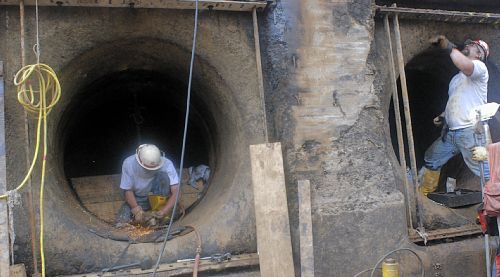Repairs Reflect Dire Need to Replace River Locks
Pittsburgh Post-Gazette
15 May 2010
By Jon Schmitz,

Parkway traffic jams pale in comparison to the one on the Ohio River on
Friday.
With the locks at Emsworth partly out of service for repairs, it was
taking towboats 15 or 16 hours to shove their coal barges through,
instead of the typical two hours, said Dave Sneberger, chief of locks
and dams for the Army Corps of Engineers.
Each barge from a 15-barge tow had to be pushed individually into an
auxiliary chamber of the aquatic elevator, towed out after the water
level was changed and then wait for the rest to come through, one by
one.
Mr. Sneberger said a typical tow costs $500 per hour to operate. "If
you're sitting there 10 hours, $5,000 just went down the tubes," he
said -- costs that trickle down to consumers.
The corps hosted a tour of the Emsworth Locks and Dams as part of a
continuing effort to raise awareness of the antiquated lock and dam
facilities on all three rivers and the consequences of inaction.
The Emsworth Locks and Dams, 6.2 miles from the Point, were completed
in 1922. The next two facilities downstream, Dashields (1929) and
Montgomery (1936) aren't much younger.
"Analysis, modeling and inspections have shown the projects to be
extremely unreliable with high probabilities of failures that could
result in unscheduled closures of up to a year," said a statement from
the corps.
The Emsworth and Montgomery dams hold back water to create a navigable
pool at the Point in Pittsburgh. Without them, it would be possible in
summer to cross the rivers on foot.
Each of the three upper Ohio facilities has a 600-foot-long main lock
chamber, making them the smallest and least efficient facilities on the
Ohio. The others are twice as long.
But it wasn't the size of the locks that triggered the Upper Ohio
Navigation Study, a long-range plan to rebuild or replace them. "The
condition of the lock chambers is what's driving the study," said
project manager Kevin Logan.
The study is scheduled to be completed in November 2011. Financing and
construction of new lock facilities could take another 20 years or more.
The main lock chamber at Emsworth, 600 feet long and 110 feet wide, has
been drained, and it was possible Friday to descend to the dried-out
river floor. Crews were working to repair the archaic valve system that
allows the lock operator to drain water from the chamber.
Large cracks, gaps and pockmarks were visible in the towering concrete
walls on either side of the lock. Officials are fearful of a collapse.
The auxiliary chamber is only 360 feet by 56 feet -- hence the
single-file barge movement on Friday.
"When the main chamber is down, it really backs up traffic," Mr. Logan
said.
If something goes wrong in the auxiliary chamber before the main lock
is returned to service May 28, river traffic would halt. Coal, which
makes up about 75 percent of the tonnage passing through Emsworth,
would not get to power plants.
Stone, gravel and cement wouldn't make it to construction sites. Barges
carrying gasoline to tank farms would be stopped, Mr. Sneberger said.
He said the rivers aren't the fastest way to convey commodities -- just
the cheapest. Shipping by rail costs eight times as much; by truck, 50
times as much.
"And it's the greenest technology we have," he said.
"People say you could send it by train or by truck" if the rivers were
closed, Mr. Sneberger said. "Rail right now is just about maxed out.
And would you want another 500 trucks running up and down the road here?
"Really, there's no alternative," he said.
Jon Schmitz: jschmitz@post-gazette.com or 412-263-1868.
